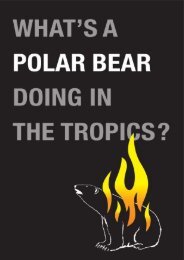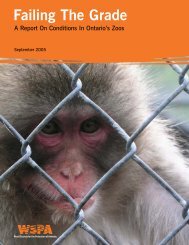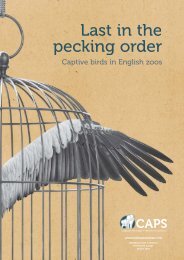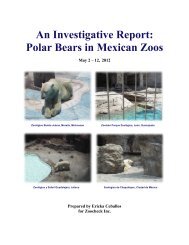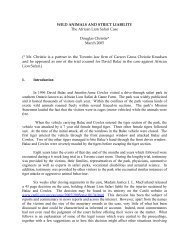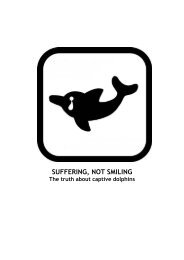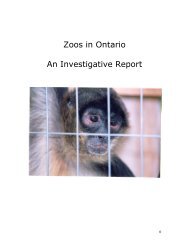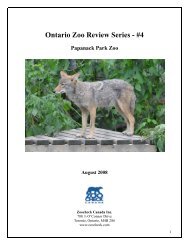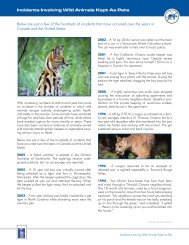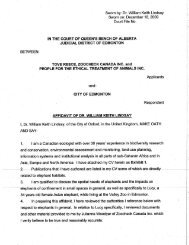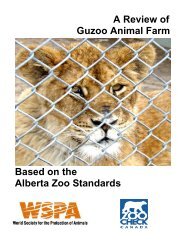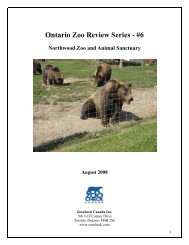STATUS OF BEAR WELFARE
STATUS OF BEAR WELFARE
STATUS OF BEAR WELFARE
Create successful ePaper yourself
Turn your PDF publications into a flip-book with our unique Google optimized e-Paper software.
Status of Bear Welfare in Cherokee, North Carolina<br />
AWA noncompliance concerns: There was insufficient shelter from inclement weather for the<br />
bears in the pits at CSBP and CBZ and the cages at SL, such that the bears were not protected<br />
from local climatic conditions and were subject to discomfort.<br />
(c) Drainage. A suitable method shall be provided to rapidly eliminate excess water. The<br />
method of drainage shall comply with applicable Federal, State, and local laws and regulations<br />
relating to pollution control or the protection of the environment.<br />
AWA noncompliance concerns: There was inadequate drainage in the pits at CSBP and CBZ,<br />
in that excess water was not rapidly eliminated, and it appears that the Oconaluftee River may be<br />
being polluted with effluent from these two facilities.<br />
Sec. 3.128 Space requirements.<br />
Enclosures shall be constructed and maintained so as to provide sufficient space to allow each<br />
animal to make normal postural and social adjustments with adequate freedom of movement.<br />
Inadequate space may be indicated by evidence of malnutrition, poor condition, debility, stress, or<br />
abnormal behavior patterns.<br />
AWA noncompliance concerns: Poor conditions, stress, and abnormal behavior patterns were<br />
prevalent in the captive bears in Cherokee. Normal social adjustments include the ability to seek<br />
privacy from cagemates, which these bears were unable to do.<br />
Sec. 3.129 Feeding.<br />
(a) The food shall be wholesome, palatable, and free from contamination and of sufficient<br />
quantity and nutritive value to maintain all animals in good health. The diet shall be prepared with<br />
consideration for the age, species, condition, size, and type of the animal. Animals shall be fed at<br />
least once a day except as dictated by hibernation, veterinary treatment, normal fasts, or other<br />
professionally accepted practices.<br />
AWA noncompliance concerns: Food can become contaminated when tossed into puddles,<br />
pools, and excrement and handled in an unsanitary manner. It was impossible for employees to<br />
determine if each bear was receiving a sufficient quantity of food during uncontrolled public<br />
feeding. Little or no consideration was given to age, species, condition, size, and type of animal in<br />
a diet that was heavily reliant on uncontrolled public feeding. The diet was not consistent with<br />
professionally accepted practices. The nutritive value of high-protein dog food, white bread,<br />
sugary drinks, iceberg lettuce, and apples as a regular diet is insufficient for bears to maintain<br />
good health.<br />
Sec. 3.131 Sanitation.<br />
(a) Cleaning of enclosures. Excreta shall be removed from primary enclosures as often as<br />
necessary to prevent contamination of the animals contained therein and to minimize disease<br />
hazards and to reduce odors. When enclosures are cleaned by hosing or flushing, adequate<br />
measures shall be taken to protect the animals confined in such enclosures from being directly<br />
sprayed with the stream of water or wetted involuntarily.<br />
AN INVESTIGATIVE REPORT <strong>OF</strong> CHIEF SAUNOOKE <strong>BEAR</strong> PARK, CHEROKEE <strong>BEAR</strong> ZOO, AND SANTA’S LAND | 39



